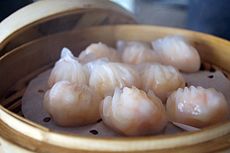Har gow: Difference between revisions
m Replace magic links with templates per local RfC and MediaWiki RfC |
Rescuing 1 sources and tagging 0 as dead. #IABot (v1.6) |
||
| Line 18: | Line 18: | ||
'''Ha gow''' (sometimes anglicized as "har gow"; {{zh|c=蝦餃| cy=hā gáau|first=j|j=haa1 gaau2| p=xiā jiǎo}}) is a traditional [[Cantonese cuisine|Cantonese]] [[dumpling]] served in [[dim sum]].<ref name="Hsiung">Hsiung, Deh-Ta. Simonds, Nina. Lowe, Jason. [2005] (2005). The food of China: a journey for food lovers. Bay Books. {{ISBN|978-0-681-02584-4}}. p41.</ref> |
'''Ha gow''' (sometimes anglicized as "har gow"; {{zh|c=蝦餃| cy=hā gáau|first=j|j=haa1 gaau2| p=xiā jiǎo}}) is a traditional [[Cantonese cuisine|Cantonese]] [[dumpling]] served in [[dim sum]].<ref name="Hsiung">Hsiung, Deh-Ta. Simonds, Nina. Lowe, Jason. [2005] (2005). The food of China: a journey for food lovers. Bay Books. {{ISBN|978-0-681-02584-4}}. p41.</ref> |
||
==Name== |
==Name== |
||
The dumpling is sometimes called a '''shrimp bonnet''' for its pleated shape. This dish is often served together with ''[[shaomai|siumaai]]''; when served in such a manner the two items are collectively referred to as ''hagaau''-''siumaai'' ({{zh|t=蝦餃燒賣|p=xiājiǎo shāomài|cy=hāgáau sīumáai|first=j|}}).<ref>Big5.China.com.cn. "[http://big5.china.com.cn/city/zhuanti/gdx08/2008-11/04/content_16708259.htm China.com.cn]." ''廣州茶飲.'' Retrieved on 2009-03-17.</ref><ref>Yahoo.com. "[http://hk.where.yahoo.com/a/article.html?id=6186 Yahoo.com]." ''街坊盅頭飯.'' Retrieved on 2009-03-15.</ref> |
The dumpling is sometimes called a '''shrimp bonnet''' for its pleated shape. This dish is often served together with ''[[shaomai|siumaai]]''; when served in such a manner the two items are collectively referred to as ''hagaau''-''siumaai'' ({{zh|t=蝦餃燒賣|p=xiājiǎo shāomài|cy=hāgáau sīumáai|first=j|}}).<ref>Big5.China.com.cn. "[http://big5.china.com.cn/city/zhuanti/gdx08/2008-11/04/content_16708259.htm China.com.cn]." ''廣州茶飲.'' Retrieved on 2009-03-17.</ref><ref>Yahoo.com. "[http://hk.where.yahoo.com/a/article.html?id=6186 Yahoo.com] {{webarchive|url=https://web.archive.org/web/20080404194146/http://hk.where.yahoo.com/a/article.html?id=6186 |date=2008-04-04 }}." ''街坊盅頭飯.'' Retrieved on 2009-03-15.</ref> |
||
==Description== |
==Description== |
||
Revision as of 01:07, 30 October 2017
Template:Contains Chinese text
 | |
| Alternative names | Xia jiao, also spelled ha gau, ha gaau, ha gao, ha gow, or other variants |
|---|---|
| Course | Dim sum |
| Place of origin | Guangdong, China |
| Region or state | Cantonese-speaking areas |
| Main ingredients | Wheat starch, tapioca starch, shrimp, cooked pork fat, bamboo shoots, scallions, cornstarch, sesame oil, soy sauce, sugar, and other seasonings |
| Har gow | |||||||||||||||||||||
|---|---|---|---|---|---|---|---|---|---|---|---|---|---|---|---|---|---|---|---|---|---|
| Chinese name | |||||||||||||||||||||
| Traditional Chinese | 蝦餃 | ||||||||||||||||||||
| Simplified Chinese | 虾饺 | ||||||||||||||||||||
| Jyutping | haa1 gaau2 | ||||||||||||||||||||
| Hanyu Pinyin | xiā jiǎo | ||||||||||||||||||||
| Literal meaning | shrimp dumpling | ||||||||||||||||||||
| |||||||||||||||||||||
| Thai name | |||||||||||||||||||||
| Thai | ฮะเก๋า [háʔ.kǎw] | ||||||||||||||||||||
| RTGS | hakao | ||||||||||||||||||||
Ha gow (sometimes anglicized as "har gow"; Chinese: 蝦餃; Jyutping: haa1 gaau2; Cantonese Yale: hā gáau; pinyin: xiā jiǎo) is a traditional Cantonese dumpling served in dim sum.[1]
Name
The dumpling is sometimes called a shrimp bonnet for its pleated shape. This dish is often served together with siumaai; when served in such a manner the two items are collectively referred to as hagaau-siumaai (Chinese: 蝦餃燒賣; Cantonese Yale: hāgáau sīumáai; pinyin: xiājiǎo shāomài).[2][3]
Description
These shrimp dumplings are transparent and smooth. The prawn dumplings first appeared in Guangzhou outskirts near the creek bazaar Deli. This dish is said to be the one that the skill of a dim sum chef is judged on. Traditionally, ha gow should have at least seven and preferably ten or more pleats imprinted on its wrapper. The skin must be thin and translucent, yet be sturdy enough not to break when picked up with chopsticks. It must not stick to the paper, container or the other ha gow in the basket. The shrimp must be cooked well, but not overcooked. The amount of meat should be generous, yet not so much that it cannot be eaten in one bite.
See also
References
- ^ Hsiung, Deh-Ta. Simonds, Nina. Lowe, Jason. [2005] (2005). The food of China: a journey for food lovers. Bay Books. ISBN 978-0-681-02584-4. p41.
- ^ Big5.China.com.cn. "China.com.cn." 廣州茶飲. Retrieved on 2009-03-17.
- ^ Yahoo.com. "Yahoo.com Archived 2008-04-04 at the Wayback Machine." 街坊盅頭飯. Retrieved on 2009-03-15.

